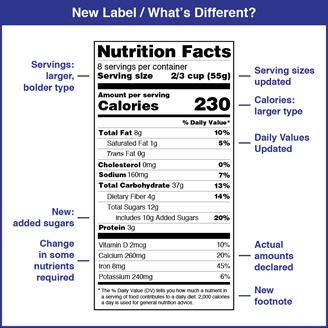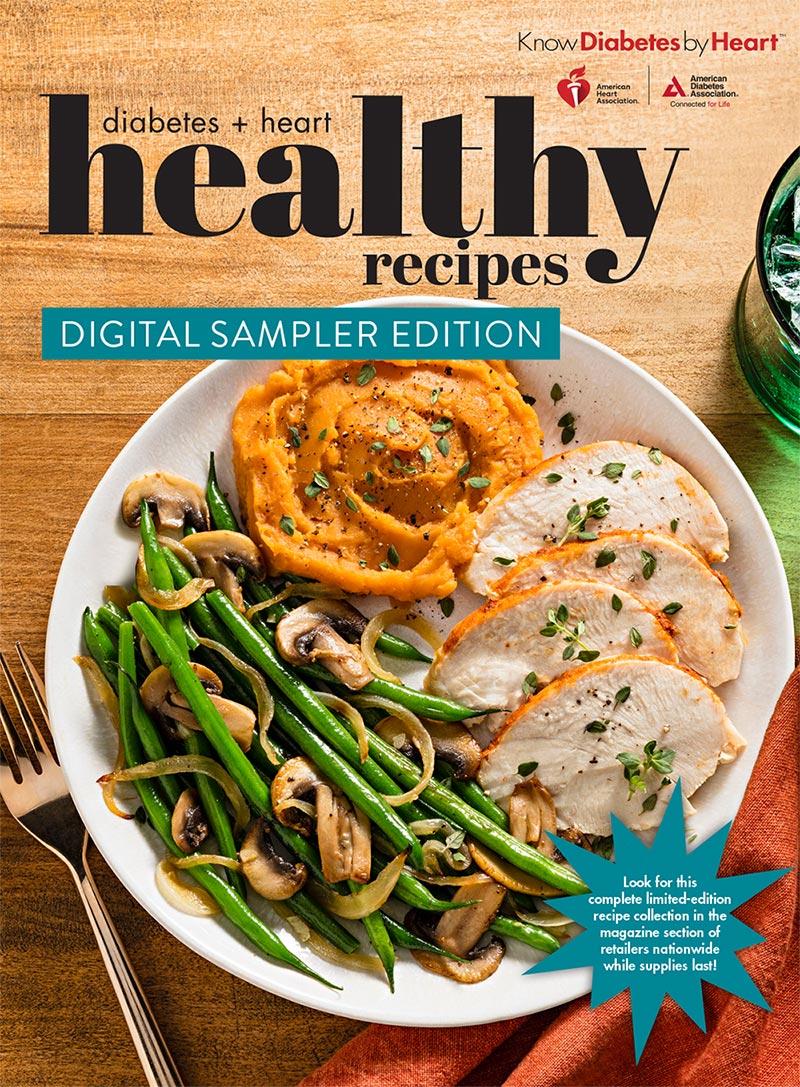Understanding the Nutrition Facts Label
Download the PDF for an easy cheat sheet to understand the nutrition facts label.
Healthy eating is an important part of managing your diabetes and keeping your heart healthy.
Learning how to read and use the Nutrition Facts label on foods can help you make healthier food choices.
If a dietitian is part of your health care team, the dietitian will often suggest counting carbohydrates (carbs) as part of your total diabetes plan. This is because the biggest rise in blood sugar is generally a result of the quantity and quality of the carbs that you eat at each meal and snack.
That is important—but so are other parts of food. For example, is the food high in saturated fat? Are there nutrients of value found in the food? Does the food have added sugars beyond those contained in the natural form of the product? These are all extremely important things to consider when making food choices, because saturated and trans fats and added sugars are linked to increased risk for heart disease.
So, let’s dive in! You can use this label to practice.

Serving Size
At the top of the label, you’ll find the serving size. Understanding the serving size will help you determine the right portion size and understand how many portions are in the package. This will also help you to make accurate calculations.
Calories
Next, you’ll find the calorie count. Pay attention to the calories per serving and how many calories you’re consuming with the portion size you are choosing.
Remember that the information shown in the label is based on a diet of 2,000 calories per day. Your calories needs will vary depending upon your age, gender, activity level, and whether you’re trying to lose, gain or maintain your weight.
Carbohydrates
Determining the carb count
Knowing the amount of carbs you’re getting per meal is important, as carbs have the biggest impact on your blood sugar. If your goal is to eat 30 grams of carbs per meal and you plan to eat 2/3 of a cup of a product, you might find that you’re getting 37 grams of carbs (four of which are grams of fiber) according to its Nutrition Facts label.
If you decide eat 1/3 of a cup of the same product, you would be getting 18.5 grams of carbs instead. Lowering your carb count by eating a smaller portion size leaves room to add something else to your meal, like an 8 oz glass of milk which has 12 grams of carbs.
If you are using portions for carb counts, one portion is 15 grams of carbs. If you eat 2/3 of a cup of this product, it would be a little more than two portions.
Counting carbs
For individuals on an insulin to carb ratio—you can use the Nutrition Facts label to help you add up the total grams of carbohydrates you are eating, then divide by the ratio.
For example, let’s take this label once again. If you are eating 2/3 of a cup of this product, it would be 37 grams of carbs. Let’s say you were also going to have an apple. No label! You can look up the nutrition information via Google or a food application and determine it has about 20 grams of carbs. Adding the two together equals 57. Now let’s say your insulin to carb ratio is 15. You would divide 57 by 15 to get 3.8 units (rounding to 4 units of insulin for that meal).
Nutrients
Another item you can find on the Nutrition Facts label is the amount of other nutrients.
Let’s say a product has 20% of the daily recommendation of 1,300 mg of calcium. This is based on a 2,000 calorie food plan, and if you consumer fewer calories per day, the percent of the daily value as listed on the label will not be true for you.
However, the label now includes nutrient measurements in milligrams. If you know you should be getting 1,300 mg of calcium a day and this product contains 260 mg/dL, it is advised for you to find other products that have calcium in them, like dairy, almonds, or tofu to bring you up to the recommended daily value.
Fats
Although fat can also contribute to changes in your blood sugar, they have less influence than carbs. However, it is important to reduce amount of saturated and trans fats as a part of a balanced diet.
Replacing foods that are high in saturated fat with healthier options can lower blood cholesterol levels and improve lipid profiles.
Sodium
Sodium is the amount of salt in food. Eating less sodium can reduce your risk of high blood pressure and bloating. It can also reduce your risk of heart attack, heart failure, stroke, kidney disease, osteoporosis, stomach cancer and even headaches.
Resources
If the product does not have a Nutrition Facts label, for example fresh fruit and vegetables, consider adding an app to your phone that allows you to look up carbs and other nutrients. There are several excellent apps out there, and if you have questions, ask your dietitian/health care team for some recommendations.
Once you’ve chosen healthy food products, you may need some inspiration. There are many healthy and delicious recipes to choose from that can help you manage your diabetes and your risk for heart disease, stroke, and chronic kidney disease.
https://www.fda.gov/food/food-labeling-nutrition/changes-nutrition-facts-label




